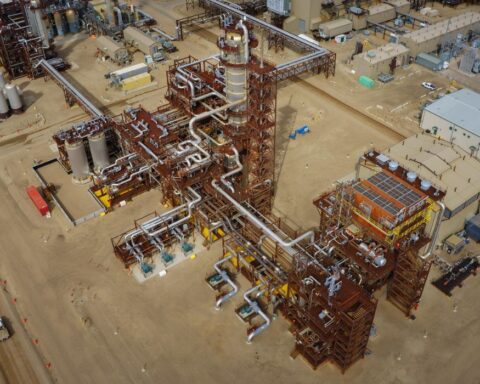Another year is drawing to a close with everyone gathering their top lists of 2024. And while you’re revisiting the best the world had to offer in pop culture, music and the arts, it’s worth a reminder of all the good-news stories on climate and clean energy progress that graced our screens in 2024.
There was a lot to choose from – something that may not be immediately apparent in the aftermath of the U.S. election and news that 2024 will almost certainly be the hottest on record.
But it’s true: Canada and the world made enormous strides addressing climate change and building a cleaner economy. Here are the top 10 stories from 2024:
Electric vehicle sales in Canada continued to rise
You may not know it from news coverage, but sales of electric vehicles in Canada are at their highest level ever. And they keep rising: market share for EVs in Canada has roughly tripled over the past three years, with the latest quarterly data showing sales at 16.5% nationally. In fact, gas vehicle sales in Canada peaked in 2017 and have been falling ever since.
The question ahead is one of pace, with Quebec rapidly taking the North American crown for EV adoption. More than one in three vehicle sales in la belle province were electric last quarter –substantially higher than runner-up California.
Globally, it was the same story: EVs rising
The trend is even more pronounced globally, where EV sales are set for another record year. A big part of the story is China – the world’s largest auto-market – where the latest data show EVs taking more than half the market. That has contributed to a peak in oil consumption in the country last year, according to the latest official estimates.
Taken together, the rise of EVs is expected to cut global oil demand by six million barrels per day by 2030, according to the International Energy Association (IEA).
Peak fossil fuels by 2030
On a related note: the IEA projected that global demand for fossil fuels will peak before 2030, thanks largely to the rapid electrification of the economy. Other forecasts, including those from oil and gas companies, have come to a similar conclusion. Global declines in the demand for fossil fuels will have important implications for Canada and the long-term competitiveness of the oil and gas sector.
Clean electricity continued to soar
As fossil fuels decline, they’re quickly being replaced by an age of clean electricity. The IEA expects roughly $2 trillion in clean energy investments in 2024, nearly double the amount invested in fossil fuels. More than 40% of electricity worldwide was non-emitting in 2023, and more than 90% of the growth in net power capacity came from wind and solar.
Provinces and territories made big moves on clean electricity
In Canada, we saw big progress on clean electricity across the country, despite some more high-profile disputes. Ontario is ramping up electrification with a goal to become a clean energy superpower. Hydro-Québec is investing up to $185 billion over the next decade to expand clean energy and electrify the province. Quebec inked a deal with Newfoundland and Labrador last week that would see a massive amount of new clean electricity come online in future years. British Columbia is charging ahead with enough new wind projects to increase power supply by 8% – with more to come in future years. The federal government recently committed up to $1 billion in Indigenous-led wind power in New Brunswick, on top of other clean energy investments. And in Saskatchewan, the federal government is investing more than $265 million in clean electricity, including Indigenous-led renewable projects.
The cost of clean energy continued to drop
The cost of clean energy continued to drop worldwide, especially in solar and battery technologies. In the first half of this year alone, for example, solar photovoltaic prices dropped 20%, according to the IEA. Solar module prices were cut in half over the past year. And grid-scale battery storage prices declined by nearly 10%.
That can’t help but have positive impacts on affordability here at home. On that front, new research released this year showed that the transition to clean electricity can save people money: most households in Canada can expect to save up to $1,100 each year by switching to more efficient technologies such as EVs and heat pumps by mid-century. That echoes earlier research from the Canadian Climate Institute that found that the switch off fossil fuels can save people money on energy costs over time.
Indigenous nations led on clean energy
Indigenous Peoples continued to lead the way on climate and clean energy in 2024. The Oneida battery storage plant – the largest facility of its kind in the country and a 50/50 partnership with the Six Nations of the Grand River in Ontario – is set to power up next summer. Likewise, an energy storage project led by the Malahat First Nation on Vancouver Island will produce enough battery power for tens of thousands of homes and support hundreds of local jobs. Indigenous Peoples are partners or beneficiaries in nearly one-fifth of Canada’s electricity generation – and almost all of that is renewables.
This year also brought important new policy research on an Indigenous electrification strategy, Indigenous participation in clean energy, and Indigenous housing and clean technologies.
Canada has made progress cutting emissions
The latest estimates from the Canadian Climate Institute show that Canada’s emissions saw a modest drop in 2023 and now sit around 8% below where they were in 2005. Climate policies are working – with industrial carbon pricing leading the pack. Canada’s emissions would be higher today without the actions taken to date by all levels of government since 2015. By 2030, existing climate policies are expected to prevent 226 megatons of emissions – the same amount as current emissions from Quebec and Ontario combined. But getting closer to Canada’s emission targets still requires more action. Governments can deliver even deeper emission cuts by following through and finalizing developing and announced policies.
Big progress electrifying buildings
This year also saw Quebec committing to 100% renewable energy to heat all buildings, except in the industrial sector, which will mean a big transition away from fossil fuels to highly efficient electric heat pumps. This type of planned transition in the building sector is necessary to protect consumers from higher costs and stranded assets. Likewise, Vancouver avoided a reversal of its nation-leading rules that effectively banned gas for heating most buildings.
Oil and gas sector makes progress cutting methane
Emissions from Canada’s oil and gas sector remain a critical challenge for climate policy, making up more than 30% of national emissions. But one area that has seen progress is methane emissions, a potent greenhouse gas. Cutting methane is a no-brainer and widely considered to be the cheapest and easiest way to slash emissions from the sector. This fall, British Columbia announced it had already cut methane emissions in half from the sector, exceeding its mandated 2025 target, and Alberta has done the same. The federal government has drafted regulations that would reduce oil and gas methane 75% by 2030. There are important caveats, with recent research finding higher estimates of methane than previously thought, but progress has generally been encouraging.
Taken together, it’s been a year of surprisingly good news in the realm of climate and clean energy. That’s not to diminish the challenges ahead – but let’s not lose sight of the progress that’s been made. And let’s redouble our efforts in 2025.
Rick Smith is president of the Canadian Climate Institute.







